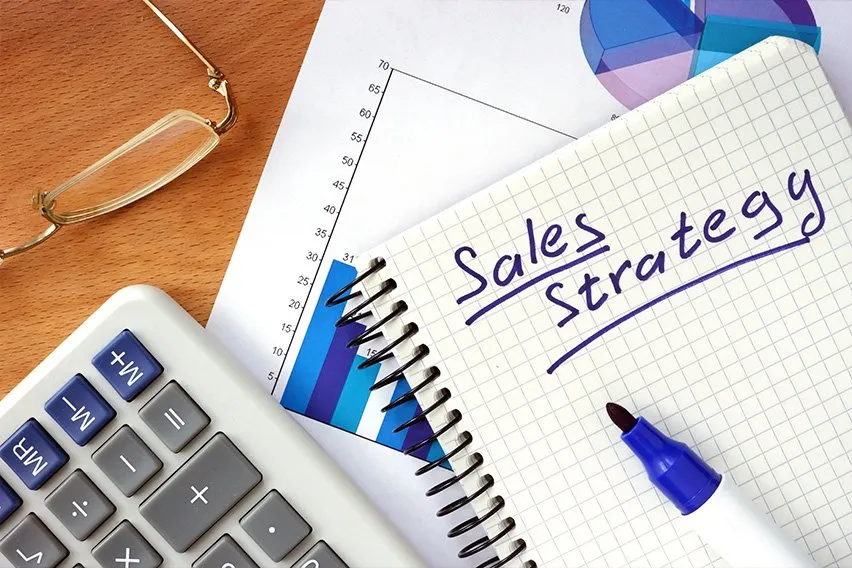The Small Business' Guide to Building an Effective Sales Strategy

Whether you’re starting a new company or revamping an existing one, developing a sales process is one of the best ways you can ensure your business’ success. But why is a sales strategy so important? And how do you create sales strategies for your company in the first place?
In this guide, you’ll learn more about important concepts such as the sales funnel and the difference between outbound and inbound sales—these concepts are the building blocks of sales marketing. Then, we’ll dive into the 10 steps to create successful sales strategies for small businesses.
Let’s get started!
What Is a Sales Strategy?
A sales strategy, also known as a sales plan, outlines your approach to selling your products or services. Sales strategies guide you on the who, what, when, where, why and how, but they mainly answer three questions:
- What is our product/service? What is our selling point?
- Who is our target market?
- How will we sell our product/service to our target market?
In addition to this, sales strategies also establish your timeline (what goals you need to meet and by when), potential risks and contingency plans to handle problems before they spin out of control.

Why You Need a Sales Strategy
All companies, big or small, NEED a successful sales strategy! Here are five reasons why:
- Address your customers’ needs: Whether you’re trying to attract new customers or cater to existing ones, a sales strategy can help you anticipate (and meet) your clients’ biggest demands. Good sales strategies outline your ideal prospect profile, the customer journey and which approaches would work best for different stages in the sales cycle.
- Improve performance and productivity: Your sales strategy is one of your sales reps’ most important tools. They standardize your sales team’s approach and help your sales reps create consistent, value-adding experiences for your customers. You’ll also be able to identify which sales tactics are actually effective, allowing you to focus your time, budget and resources on the practices with the best return on investment (ROI).
- Identify problems and opportunities: A detailed sales strategy contains data and analysis that could point out what you’re doing right, and what you need to improve on. From competitor research and product positioning to action plans, the information laid out in your sales strategy will help you find opportunities for growth and potential problems that could surface down the line.
- Hire the right people for your sales teams: If you want to boost your sales and grow your business, getting the right people on your sales team is imperative. If you understand your goals and what you need to do to achieve them, then you’ll be able to hire employees with the necessary skills, experience and approach to selling.
- Grows as your business does: The thing about sales strategies is that what works at one stage of your business’ development may not work as you progress. While this means that you’ll have to make a new sales strategy as you expand your product or service offering, it also means that you’re always prepared for new challenges.
The Sales Funnel
Before you dive into the difficult work that is developing a sales strategy, you first need to understand one of the core concepts of sales: the sales funnel.
The funnel (a.k.a. pipeline) is the process that turns a prospect into a paying customer. We can break it down into four basic stages:
- Awareness: In this stage, your main goal is to build awareness of your brand. This usually involves marketing campaigns and developing an initial list of prospects to sell to.
- Interest: Once more people know about your company, you can start drumming up interest in your products and services. Promote your product’s unique features, create a “brand” or “lifestyle” around your business, and encourage potential customers to look into the goods or services that you’re offering.
- Desire: Your most qualified leads will make it to the third stage of the sales funnel—desire. In the desire stage, your prospect is already thinking of purchasing your product. Common practices during this stage are demos, meetings and negotiations to entice your prospect.
- Action: The last stage is closing the deal. At this point, your prospect will either sign up for a trial or make an actual purchase.
BONUS—Retention: Your sales process shouldn’t end after you secure a prospect; instead, continue developing a relationship with them so that they become loyal, repeat customers of your product or service.
A sales strategy should define what kind of messaging and approaches are best for each stage.
Inbound vs. Outbound Sales
Although there are many different ways to classify and categorize sales, one of the simplest (and most common) ways to do it is to group it into inbound versus outbound sales.
Inbound sales strategies focus on how to get customers to come to you. The prospect initiates the sales process, by clicking on your website, signing up for your newsletter and researching your products. Common inbound sales practices involve search engine optimization (SEO) and content marketing.
Outbound sales strategies, on the other hand, focus on how you can connect with your customers. Your company initiates the contact, usually through cold calling, cold emailing and social media posting.
Neither one of these approaches is better than the other. Some businesses may benefit more from inbound sales while others rely on outbound sales. Some companies even combine the two or swing back and forth depending on their situation at the time.
How to Develop an Effective Sales Strategy
Assess Your Business
First things first, you need to take a step back and look at your successes, failures and current situation. This helps you identify your best practices, opportunities for improvement and whether or not your business is ready to expand.
A data-driven assessment is one of the best ways to ground yourself in reality. Look at the numbers and facts—how much did you sell? Which products are the most popular? Who were your easiest and most profitable customers? Understand your past performance and you’ll be better prepared to plan for the future.
Set Clear and Measurable Goals
Goal-setting is a crucial part of your sales strategy. After all, you can’t strategize if you don’t know what you want to achieve in the first place. Plus, defining your objectives allows you to track your progress and measure the success of your campaign.
Your sales goals should always be 1) specific, 2) realistic and 3) measurable. Specific means that your aims should be well-defined, focused and clear. Realistic means that they should be achievable within your given time frame. Measurable means that there’s a concrete way to quantify your success or failure.
Here are some examples of specific, realistic and measurable goals:
- Increase qualified leads per month by 10%
- Hit a target of $5,000 in new sales per month per sales rep
- Reduce time spent on non-sales-generating activities (emailing, scheduling) by 30 minutes a week
Understand Your Ideal Customer
As much as you want to, you can’t sell to everyone. You need to understand what kinds of customers are most likely to buy from you. Focus your efforts on selling to these customers instead of wasting resources on converting others.
A customer profile acts as a guideline for your sales teams when generating leads and prospecting. Answer these questions to come up with a clear profile of your target customer:
- Demographic: How old is your target customer? What’s their gender? What do they do? Where do they live? How much do they earn?
- Psychographic: What kinds of problems do your target customers experience? What entices them to make a purchase? What motivates them to follow and patronize a brand?
Find the Unique Selling Point of Your Product
Each business has a unique selling point (USP) that makes them stand out from the competition. To identify your niche, you need to have a deep understanding of your product, your competitors’ offerings and your industry.
Most companies differentiate themselves on product, usually on price or quality. Some set themselves apart based on the customer experience—same-day deliveries, multiple payment channels and quick customer service are just a few examples of how experience can be a differentiating feature.
Map out the Customer Journey and Sales Process
How do you want your prospects to move down the sales funnel? A customer journey map helps you understand what potential clients go through as they interact with your business and, eventually, make a purchasing decision. The more you know about their experience, the better you can guide them towards your objective: a sale.
A good sales funnel moves customers quickly down the pipeline without wasting too much time or resources. But make sure that you are still nurturing leads and building relationships with potential customers—move too quickly, and you could be neglecting some potentially profitable connections.
Recruit the Right Sales Team
While a good sales strategy lays the foundation for success, strategy can only take you so far. To really succeed, you’ll need the right people to execute your ideas.
Think of this is as the internal version of the target customer profile, otherwise known as a customer persona. Based on your goals, what kind of employees do you need? What fields or backgrounds are the most relevant to the position? What kind of attitude and/or personality would fit well with your company culture?
When it comes to sales, investing in human resources is never a losing strategy. After all, your sales reps are the ones bringing in money, so you should take extra care when filling out your team.
Build a List of Prospects
Prospecting is all about finding the people who fit your target customer persona and are most likely to convert. Having a list of qualified leads means that you maximize your time, money, manpower and other resources by focusing on the prospects with the highest likelihood of returns.
Building your list doesn’t have to be complicated or time-consuming. It can be as simple as networking at events or asking for referrals from existing customers. You can also add a sign-up form on your site so that potential leads come to you.
Outline Your Sales Pitch
A sales strategy isn’t complete without sales pitch guidelines. If a sales journey/map outlines how your customer goes down the pipeline, the sales pitch outlines exactly how your sales reps are supposed to take them there.
This includes developing your key messaging. Avoid generic templates you find online and zero in on what really makes your business special. A sales pitch should also contain common objections or hesitations, as well as how to handle them.
Create an Action Plan
Once your strategy is rounded out, it’s time to translate it into concrete actions that you and your sales teams can follow. Your action plan should be objective-based—take your goals and break them down step-by-step until you have several mini-objectives that collectively bring you closer to your overarching goal. Then, plot it out on a timeline and delegate tasks to the right people for the job.
When implementing your action plan, make sure you focus on the most immediate goals, or the goals that have the most “domino” impact. Monitor your team’s progress regularly to ensure that you’re always on track.
Track and Analyze Data
You have your benchmarks, sales pitch and action plan all laid out. You’ve been using your sales strategy for a couple of months to some success. What now? Is your job over?
Sales is an ongoing process, which means that your work has really just begun. The next step is to track your team’s performance and use that data to make your sales strategy even stronger. By documenting your efforts and comparing numbers, you’ll be able to see which actions contributed positively to your business and which are merely a waste of time and resources.

Other Tips for Sales Success
Focus on Existing Customers
Your current customers are already fans of your brand, so why not tap into the resource you’ve invested so much in? Existing customers can help in a couple of ways: 1) by giving feedback about your products, customer service, and the overall experience with your brand, and 2) by referring you to other people who may become customers in the future.
Go Back to Failed Leads
Just because a lead didn’t turn into a customer doesn’t mean they are a dead end. In fact, failed customers can be a valuable source of information and feedback.
Talk to prospects that fell through (it’s a bonus if they dropped out of the sales process at different stages). Ask them for constructive criticism, learn their reasons for not signing on, and then use their feedback to improve your sales strategy.
Develop Strategic Partnerships
Business is a cutthroat industry—while one company may succeed on its own, many build their success on the failures of others. However, not all businesses are out to succeed at your expense. In fact, developing strategic partnerships and alliances is a great way to boost sales for all parties involved.
The trick here is to find a business that offers products that are related to yours without being in direct competition with them. For example, a website design business may choose to partner up with an SEO agency, allowing both companies to increase their reach and appeal.
Align with Your Marketing Strategy
Marketing and sales are two sides of the same coin. The key here is synergy—your sales strategy needs to support and be supported by your marketing strategy. Your messaging and brand identity need to be consistent across all channels, from your sales reps and your commercials to your packaging. A consistent message is easier to spread and it makes your brand easier to trust.
Bundle or Discount Your Products
Packaging your products together (or bundling) is a common tactic that businesses use to drive sales. When you bundle two or more products together, the overall value of the bundle is often greater than the sum of its parts. Combine that with a special, discounted bundle price and customers will be willing to shell out more. This strategy could help you get rid of stock, push certain kinds of products and reduce costs.
Make the Most out of Social Media
Social media platforms like Facebook, LinkedIn, Twitter, Instagram and Pinterest have revolutionized how we do business. Having a strong online presence is one of the best ways to build brand awareness, attract new customers and move product.
More than just a way to sell goods and services, social media can help you create stronger relationships with your customers. Treat it as a channel for communication by posting relevant content and interacting with the community on a regular basis.
Conclusion
A successful sales strategy helps pave the way towards profit, so it’s important to put as much time and effort into it as you would with marketing, production and other aspects of your business. But even if it may seem like complicated or tedious work, it will eventually pay off with increased sales, more productive employees and stronger relationships with your clients.
RELATED ARTICLES

 10 Cash Flow Management Tips to Grow Your Business
10 Cash Flow Management Tips to Grow Your Business Protect Your Business: 10 Types of Business Fraud to Look out For
Protect Your Business: 10 Types of Business Fraud to Look out For Owner’s Draw vs. Salary: Paying Yourself as a Business Owner
Owner’s Draw vs. Salary: Paying Yourself as a Business Owner How to Avoid a Bad Hire: 5 Hiring Mistakes Identified
How to Avoid a Bad Hire: 5 Hiring Mistakes Identified How to Hire Good Employees in 8 Easy Steps
How to Hire Good Employees in 8 Easy Steps Boost Your Profits Without Increasing Sales: A How-To Guide
Boost Your Profits Without Increasing Sales: A How-To Guide